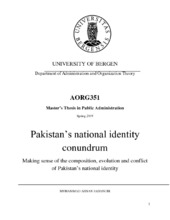Pakistan’s national identity conundrum: Making sense of the composition, evolution and conflict of Pakistan’s national identity
Master thesis

View/
Date
2019-06-15Metadata
Show full item recordCollections
- Master theses [91]
Abstract
Pakistan has been struggling with its national identity since its inception in 1947. This crisis of identity has been persistent throughout the years. The basis and rationale for Pakistan, which is marred with confusion and ambiguity, is still discussed and talked about amongst the intelligentsia as well as the common people of the country. After independence from the British, there were two paths towards the future of the country. The first one was to work on the nation building in the country, creating democratic institutions for inclusive and participatory democracy, recognize and accommodate the ethnically, socially and culturally diverse groups and build a new country accommodating everyone. This path would have been taken if the country’s leadership had realized that the ‘two nation theory’ was important for the creation of Pakistan but that it had outlived itself once the country was created. The second path was the continued use of the two nation theory as the basis of a homogenous Pakistani national identity. Ignoring the ethnic and cultural diversity in the country and using the symbols of one language and one faith to create a new national identity that everyone could not relate to. The state of Pakistan chose to follow the later. The result was a continued confusion regarding the national identity and a persistent conflict of the local ethnic identities with the national identity. Even after the separation of the country’s Eastern Wing, the state has not changed its stance regarding the two nation theory as a basis of Pakistani nationalism. Today’s Pakistan on one hand still uses the Urdu language and the Muslim faith in a bid to create a homogenous Pakistani identity and on the other hand continues to struggle to contain the national identity crisis and the ethnic identity conflict in Pakistan. My research is a bid to use the theoretical knowledge and available data to build an understanding of the Muslim nationalism in the sub-continent, circumstances of the partition and the birth of the Pakistani nationalism. In this context, I will take a detailed look at the composition, evolution and crisis of the Pakistan’s national identity and the ethnic conflict as a result.
Publisher
The University of BergenCopyright
Copyright the Author. All rights reservedRelated items
Showing items related by title, author, creator and subject.
-
Negotiating Contested Identities: Palestinian American Identity in Poems by Lisa Suhair Majaj, Naomi Shihab Nye, and Susan Abulhawa
Lessen, Klara Gesine Van (Master thesis, 2019-06-21)Denne masteroppgaven tar for seg poetiske fremstillinger av sammensatte identiteter i verkene til tre Palestinsk Amerikanske samtidsdiktere som, direkte eller indirekte, har det komplekse forholdet mellom USA og Palestina ... -
Dance encounters. Exploring Cook Islands identity through staged performances.
Jensen, Camilla Aasmundsen (Master thesis, 2012-12-15) -
Cell identity and nucleo-mitochondrial genetic context modulate OXPHOS performance and determine somatic heteroplasmy dynamics
Lechuga-Vieco, Ana Victoria; Latorre-Pellicer, Ana; Johnston, Iain; Prota, Gennaro; Gileadi, Uzi; Justo-Méndez, Raquel; Acín-Pérez, Rebeca; Martínez-De-Mena, Raquel; Fernández-Toro, Jose María; Jimenez-Blasco, Daniel; Mora, Alfonso; Nicolás-Ávila, Jose A.; Santiago, Demetrio J.; Priori, Silvia G.; Bolaños, Juan Pedro; Sabio, Guadalupe; Criado, Luis Miguel; Ruíz-Cabello, Jesús; Cerundolo, Vincenzo; Jones, Nick S.; Enríquez, Jose Antonio (Journal article; Peer reviewed, 2020)Heteroplasmy, multiple variants of mitochondrial DNA (mtDNA) in the same cytoplasm, may be naturally generated by mutations but is counteracted by a genetic mtDNA bottleneck during oocyte development. Engineered heteroplasmic ...